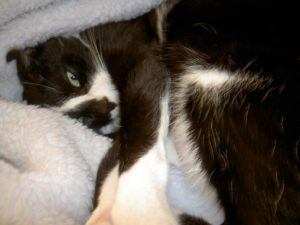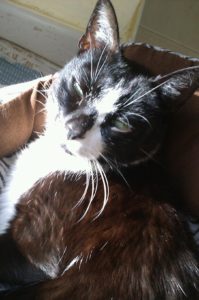Holistic Support & Best Diet For Cats With Kidney Disease

Zoltan
Updated 7/5/20
Zoltan the cat
One of my clients has a 13 year old kitty named Zoltan who has struggled with pancreatitis, which is why he originally reached out to me. He is now eating a much better diet, and his pancreatitis has subsided drastically. However, recent blood work revealed elevated kidney levels. His owner is now using a blend of kidney support supplements, but his vet is pushing a prescription kidney diet with lower protein levels. The veterinary food has a high number of carbohydrates which will most likely re-trigger his pancreatitis. What’s a cat parent to do? Both issues are serious so how do you know which direction to go?
Kidney disease is the most common disease cats develop and ultimately died from. I’ve had four cats over the years who developed this disease, and after Kiwi died from it I knew I had to make some preventative changes to help my other cats. In the 2018 Animal Wellness Summit I attended online one of the topics caught my eye, and I knew I had to watch it. It dealt with one of the most confusing issues surrounding cats with kidney disease: the best diet to feed them and holistic ways to provide support.
How kidney failure in cats starts
First, it’s important to understand how kidney disease and kidney failure develops. The kidneys are made up of little tubules called nephrons. Their job is to filter and reabsorb fluid. There are so many nephrons available in younger cats that the body holds a portion in reserve. With age or in cases of kidney damage, nephrons stop functioning and the reserves kick in. Dr. Karen Becker, DVM, describes the progression of the disease:
With no nephrons left in reserve, as damage to the kidneys progresses, signs of chronic kidney disease will start to appear. Because of the system of reserve nephrons, there are no signs of kidney insufficiency until the damage is really significant. When two thirds of the nephrons are lost, the kidneys will no longer be able to conserve water, and the cat will pass larger amounts of dilute urine. By the time that the creatinine levels are elevated on a kitty’s blood work, 75 percent of nephrons in both kidneys are gone.
Do cats need a low protein kidney diet?
I shudder to think back on how I used to feed my cats strictly a dry food diet. I realize now that the lack of moisture in their diet contributed greatly to my cats’ kidney disease. Years later I began combining kibble with some wet food. I still remember coming home from the vet the day we had to put Kiwi to sleep. The first thing I did was throw all the remaining kibble we had in the trash. From that day forward my cats were on a wet diet. They were so excited! The looks on their faces were priceless. It was almost like they were saying to themselves, “Yay! Mom finally got it!”
Many vets today recommend a low protein diet for cats with kidney disease. The school of thought was that too much protein in the diet was too hard on the kidneys. However, this assumption is incorrect, as Dr. Becker explains:
Many veterinarians still insist that a renal diet should be low in protein, despite studies that show aging pets — including those with kidney disease — need more, not less protein. But it has to be very high quality protein. So here’s the thing. If your cat is addicted to a food with rendered ingredients, meaning if your cat is eating a poor quality food that is difficult to digest and process, I do recommend you reduce the amount of toxic protein in the diet.
However, if your cat is eating human-grade protein, then protein restriction is often counterproductive and actually exacerbates problems of weight loss and cachexia (muscle wasting) — two common health issues for cats with failing kidneys. Many veterinarians will suggest a prescription dry food diet for kidney disease, but I absolutely recommend against this as well. Unless a prescription dry food is the only food your cat will consume, I don’t recommend you feed prescription dry kidney diets.

Zoltan
The best diet for cats with kidney disease
The presentation I watched on this topic during the Animal Wellness Summit was by Dr. Ruth Roberts, an integrative veterinarian and holistic health coach for pets. She has thoughtfully put together a holistic treatment plan for kitties diagnosed with kidney disease, and the first step is improving nutrition. She suggests the following:
- Feed a cooked or wet food diet instead of raw. It’s easier for cats with chronic kidney disease to digest.
- Avoid a high carbohydrate diet. Even grain free food can have way too many carbs. Often times plant proteins (like peas and legumes) are used to artificially inflate the protein levels, so you have to read the labels carefully.
- Feed highly digestible foods. Think animal protein, not plant protein. Cats don’t have the enzymes to break down plant proteins well.
- Feed a diet that is about 30% protein.
- Use a phosphorus binder. This binds to the phosphorus in the food and passes through the digestive tract and out of the body in the stools instead of being absorbed into the bloodstream. Phosphorus that is absorbed into the bloodstream has to be filtered through the kidneys and puts more stress on them.
More dietary tips
Increasing water intake is vital for cats. This offsets the higher phosphorus and protein levels. If your cat already eats a wet diet you have a head start. Need more ways to get your cat to drink more water? Try a pet fountain or adding a filter to your water to improve the taste. If your cat is a kibble-aholic, try adding water or bone broth to the kibble.
Feed your cat real food, not processed “feed grade” food with meat meals, by-products, carbohydrates and fillers. Human grade food is easier to digest. Your cat may benefit from a little extra fiber like fresh pumpkin or a little bit of psyllium husk mixed in if stools are hard or if you see any signs of constipation. One of the biggest challenges with cats who don’t feel well is to keep them eating. As kidney disease progresses you may have to find creative ways to keep up the appetite. Alfalfa has been used successfully to help with this, and you can also explore herbal and homeopathic formulas and adding broths to the food.
Decrease inflammation
The next step that Dr. Roberts recommends is to decrease inflammation. Chronic inflammation puts more stress on the kidneys, so here are several things you can do to decrease it:
- Feed a lower carb diet. Carbohydrates promote inflammation so you have to read the pet food labels! (Holistic vets I follow recommend 6-8%. Not sure how to determine how many carbs are in your cat’s food? Read this article.)
- Use high doses of omega 3s. She recommends 25-50 mg/lb, so you’ll need to find a concentrated product.
- Use a supplement called Quercetin. It’s a phytonutrient that has anti-inflammatory and antioxidant properties. Quercitin prevents advanced glycation end products (AGE) deposits in the kidneys which cause scarring and loss of kidney function. AGEs are compounds resulting from cooking proteins at high heat levels. She recommends 100-200 mg daily.
- Rhubarb root. This increases blood flow to the kidneys and reduces inflammation. She recommends 1 drop per 10 pounds of body weight twice a day.
- Reduce stress. When stress levels decrease cortisol decrease, too; lower cortisol levels reduce inflammation.

Zoltan
Improve kidney function
For a cat with kidney damage the main goal should be to support and try to improve kidney function. Unfortunately nephrons don’t regenerate, so the goal is to support the remaining ones and provide the best quality of life possible. There are several ways to do this. Along with using the supplements mentioned above (Quercitin, rhubarb root, and omega 3s), increasing moisture in the food, and using phosphorus binders, your vet may also offer a few “conventional” options:
- Control blood pressure, if elevated, with medication. If blood pressure is elevated it can further damage the kidneys.
- Administer sub-cutaneous fluids. Fluid therapy helps to flush out the toxins and preserve kidney function.
- Stem cell therapy for kidneys with PRP (platelet rich plasma) can also improve kidney function. The body signals the stem cells to make new, healthy versions of the ones that were damaged. Check out this amazing story here how it worked for a cat named Kitters.
Improve gut health
Finally, improving your cat’s gut health is another way to provide support for a cat with kidney disease. A great microbiome helps improve the immune system and creates an anti-inflammatory response. Some cats can simply use a good quality probiotic with a high number of bacteria strains to help restore restore and balance the gut flora.
Another alternative therapy that’s gaining momentum and recognition is called MicroBiome Restorative Therapy. This type of therapy uses the fecal material of super healthy animals to restore the healthy gut flora of sick or unhealthy animals. Fecal transplants can be given orally with capsules or rectally as a slurry. Dr. Margo Roman, DVM has pioneered using this holistic treatment along with medical ozone therapy for many years in patients suffering from allergies, IBD, behavior issues, cancer, and more. It has even helped cats with kidney disease. In one particular case the kidney disease was completely reversed! The seventeen year old cat at the time lived another seven years without the disease returning. Learn more in this interview by Dr. Karen Becker with Dr. Roman below. It’s truly a fascinating holistic therapy!
Try using the recommendations from Dr. Roberts in order to give your cat the very best kidney support possible. If you’re interested in finding a vet who uses MBRT/fecal transplants in their practice Dr. Roman suggests searching for vets at www.ahvma.org. If your vet is interested in learning more about this amazing therapy Dr. Roman is happy to consult with them. In Zoltan’s case I was able to muscle test the supplements as well as the food in order to provide his dad the best tools to support his precious kitty. Muscle testing can determine exactly which products and therapies will work best for your cat in order to provide the best quality of life possible.
Do you have a cat with kidney disease? If so, have you tried using any of the recommendations above? Share in the comments below! Sharing this article on your favorite social channels will help spread the word about holistic health for cats.😺

